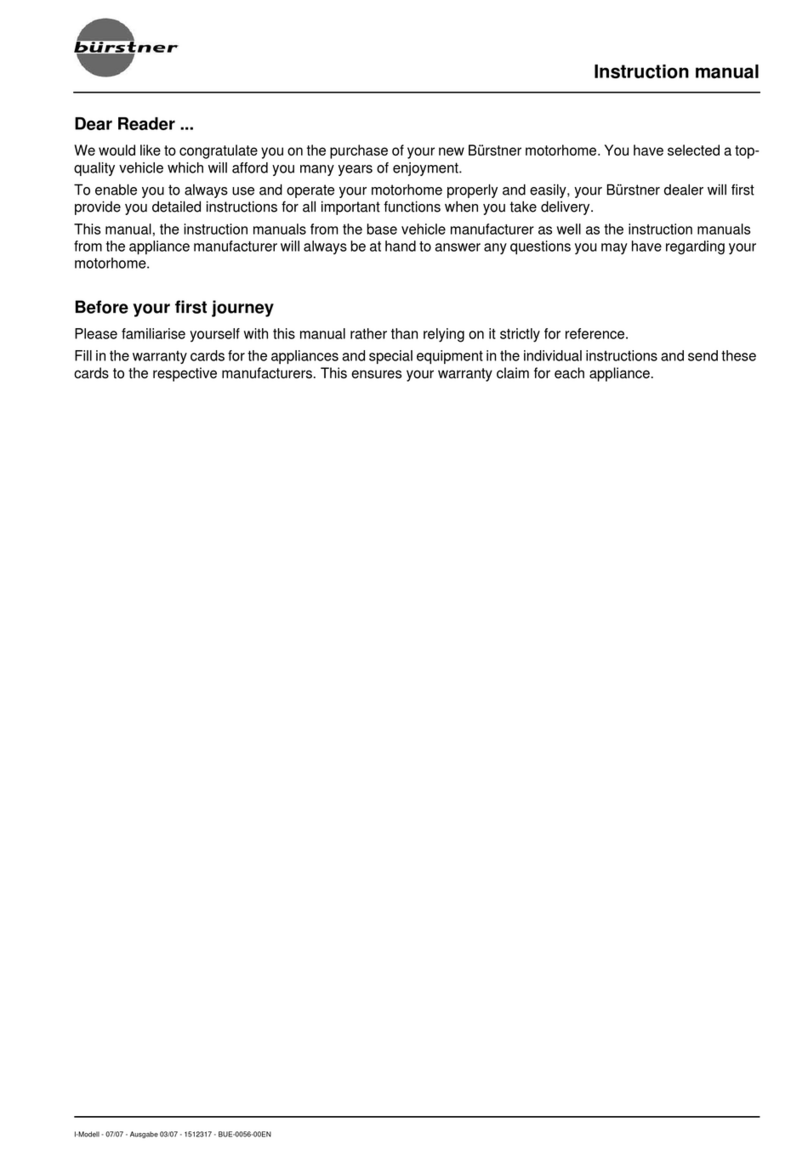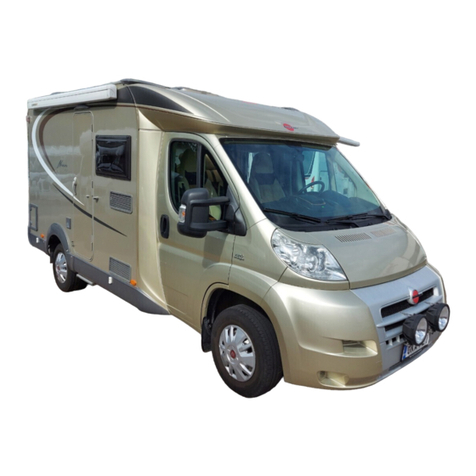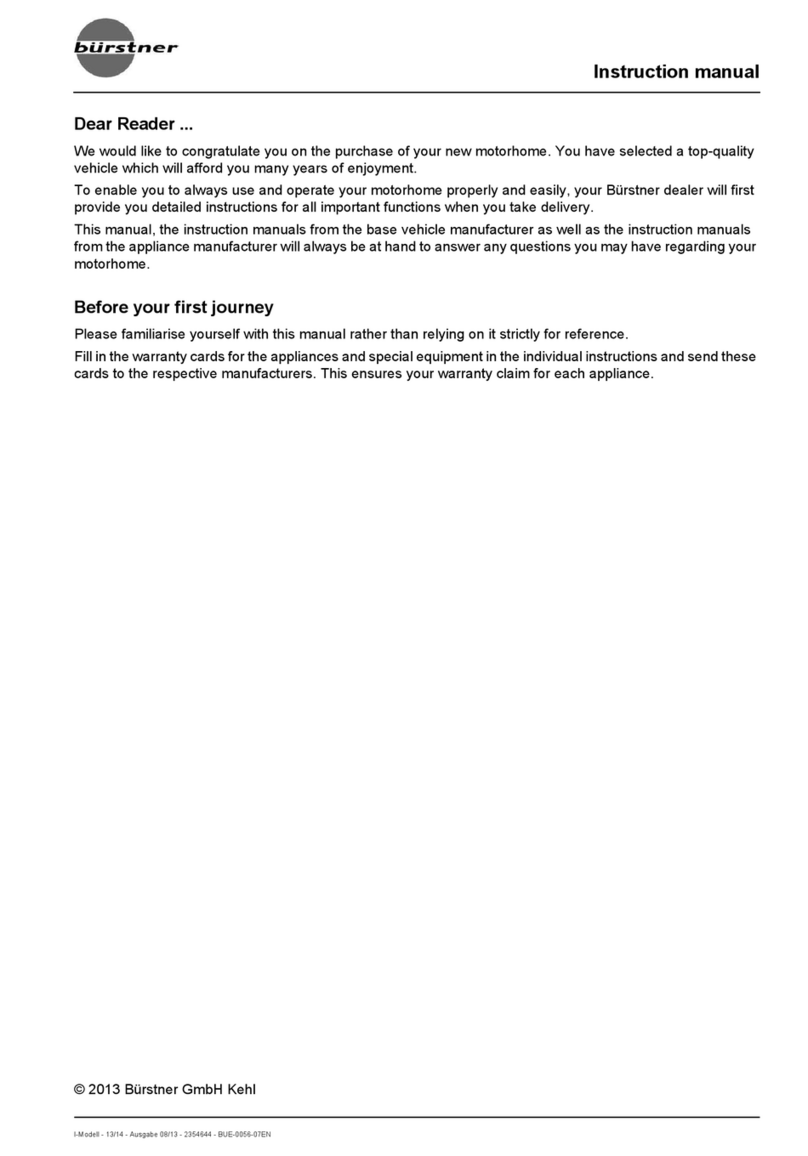
3T-Modell - 17/18 - Ausgabe 09/17 - 2891569 - BUE-0029-19EN
Contents
1Introduction. . . . . . . . . . . . . . . . . . . 7
1.1 General . . . . . . . . . . . . . . . . . . . . . . . . . 8
1.2 Environmental tips. . . . . . . . . . . . . . . . . 8
2Safety. . . . . . . . . . . . . . . . . . . . . . . . 11
2.1 Fire prevention . . . . . . . . . . . . . . . . . . 11
2.1.1 Avoidance of fire risks. . . . . . . . . . . . . 11
2.1.2 Fire-fighting . . . . . . . . . . . . . . . . . . . . . 11
2.1.3 In case of fire. . . . . . . . . . . . . . . . . . . . 11
2.2 General . . . . . . . . . . . . . . . . . . . . . . . . 12
2.3 Road safety. . . . . . . . . . . . . . . . . . . . . 12
2.4 Towing. . . . . . . . . . . . . . . . . . . . . . . . . 14
2.5 Gas system . . . . . . . . . . . . . . . . . . . . . 14
2.5.1 General instructions . . . . . . . . . . . . . . 14
2.5.2 Gas bottles . . . . . . . . . . . . . . . . . . . . . 15
2.6 Electrical system . . . . . . . . . . . . . . . . . 16
2.7 Water system . . . . . . . . . . . . . . . . . . . 16
3 Before the journey . . . . . . . . . . . 17
3.1 Keys . . . . . . . . . . . . . . . . . . . . . . . . . . 17
3.2 Registration . . . . . . . . . . . . . . . . . . . . . 17
3.3 Payload . . . . . . . . . . . . . . . . . . . . . . . . 17
3.3.1 Terms . . . . . . . . . . . . . . . . . . . . . . . . . 18
3.3.2 Calculating the payload. . . . . . . . . . . . 20
3.3.3 Loading the vehicle correctly. . . . . . . . 21
3.3.4 Rear garage/rear storage space . . . . . 22
3.3.5 Bike rack (special equipment) . . . . . . . 23
3.3.6 Load rack SAWIKO
(special equipment). . . . . . . . . . . . . . . 25
3.4 Towing. . . . . . . . . . . . . . . . . . . . . . . . . 26
3.5 Caravan coupling
(special equipment). . . . . . . . . . . . . . . 27
3.6 Electrically operated entrance step
(partially special equipment) . . . . . . . . 28
3.7 TV unit (special equipment) . . . . . . . . 29
3.8 Sink and drain basic covers
(partially special equipment) . . . . . . . . 29
3.9 Securing add-on parts. . . . . . . . . . . . . 30
3.10 Gas regulator . . . . . . . . . . . . . . . . . . . 31
3.11 Snow chains (special equipment) . . . . 32
3.12 Road safety. . . . . . . . . . . . . . . . . . . . . 33
4 During the journey . . . . . . . . . . . 35
4.1 Driving the motorhome . . . . . . . . . . . . 35
4.2 Reversing camera
(special equipment). . . . . . . . . . . . . . . 36
4.3 Driving speed . . . . . . . . . . . . . . . . . . . 36
4.4 Brakes . . . . . . . . . . . . . . . . . . . . . . . . . 37
4.5 Air suspension Goldschmitt
(special equipment). . . . . . . . . . . . . . . 37
4.6 Seat belts . . . . . . . . . . . . . . . . . . . . . . 38
4.6.1 General . . . . . . . . . . . . . . . . . . . . . . . . 38
4.6.2 Fastening the seat belt correctly . . . . . 38
4.7 Child restraint systems . . . . . . . . . . . . 39
4.8 ISOFIX child safety seat mounting
system (special equipment) . . . . . . . . 41
4.9 Pilot seats for the driver's and
front passenger's seats . . . . . . . . . . . . 42
4.10 Seat heater (special equipment) . . . . . 42
4.11 Headrests . . . . . . . . . . . . . . . . . . . . . . 43
4.12 Seating arrangement . . . . . . . . . . . . . . 43
4.13 Roman shade in the
driver's cabin . . . . . . . . . . . . . . . . . . . . 44
4.13.1 Pleated Roman shades . . . . . . . . . . . . 44
4.13.2 Roman shades, Remis
(partially special equipment) . . . . . . . . 45
4.14 Refuelling. . . . . . . . . . . . . . . . . . . . . . . 45
4.15 Topping up AdBlue®
(Citroen base vehicle) . . . . . . . . . . . . . 46
5 Pitching the motorhome . . . . . . 47
5.1 Handbrake . . . . . . . . . . . . . . . . . . . . . . 47
5.2 Entrance step. . . . . . . . . . . . . . . . . . . . 47
5.3 Ramps . . . . . . . . . . . . . . . . . . . . . . . . . 47
5.4 Wheel chocks . . . . . . . . . . . . . . . . . . . 47
5.5 Supports . . . . . . . . . . . . . . . . . . . . . . . 48
5.5.1 General instructions. . . . . . . . . . . . . . . 48
5.5.2 Steady legs (special equipment) . . . . . 48
5.5.3 Steady legs (AL-KO)
(special equipment) . . . . . . . . . . . . . . . 49
5.6 230 V connection . . . . . . . . . . . . . . . . . 50
5.7 Refrigerator . . . . . . . . . . . . . . . . . . . . . 50
5.8 Satellite unit (special equipment). . . . . 50
5.8.1 Satellite unit with manual
satellite selection (TeleSat) . . . . . . . . . 50
5.8.2 Satellite unit with automatic
antenna alignment (Teleco) . . . . . . . . . 52
5.8.3 Satellite unit with automatic
antenna alignment
(Oyster Premium) . . . . . . . . . . . . . . . . 53
5.9 Awning (special equipment). . . . . . . . . 55
6Living. . . . . . . . . . . . . . . . . . . . . . . . 57
6.1 Central locking system
(special equipment) . . . . . . . . . . . . . . . 57
6.2 Conversion door . . . . . . . . . . . . . . . . . 58
6.2.1 Conversion door, outside
(partially special equipment) . . . . . . . . 58
6.2.2 Conversion door, outside. . . . . . . . . . . 59
6.2.3 Conversion door, inside . . . . . . . . . . . . 59
6.2.4 Window of conversion door
(partially special equipment) . . . . . . . . 60
6.2.5 Folding insect screen on
the conversion door
(partially special equipment) . . . . . . . . 60
6.3 External flaps . . . . . . . . . . . . . . . . . . . . 61
6.3.1 Flap lock with recessed handle . . . . . . 61
6.3.2 Garage flap emergency release . . . . . 62
6.3.3 Flap lock with push button . . . . . . . . . . 62
6.3.4 Service unit flap lock . . . . . . . . . . . . . . 63
6.4 Furniture flaps . . . . . . . . . . . . . . . . . . . 63
6.4.1 Furniture flaps with push button. . . . . . 63

































